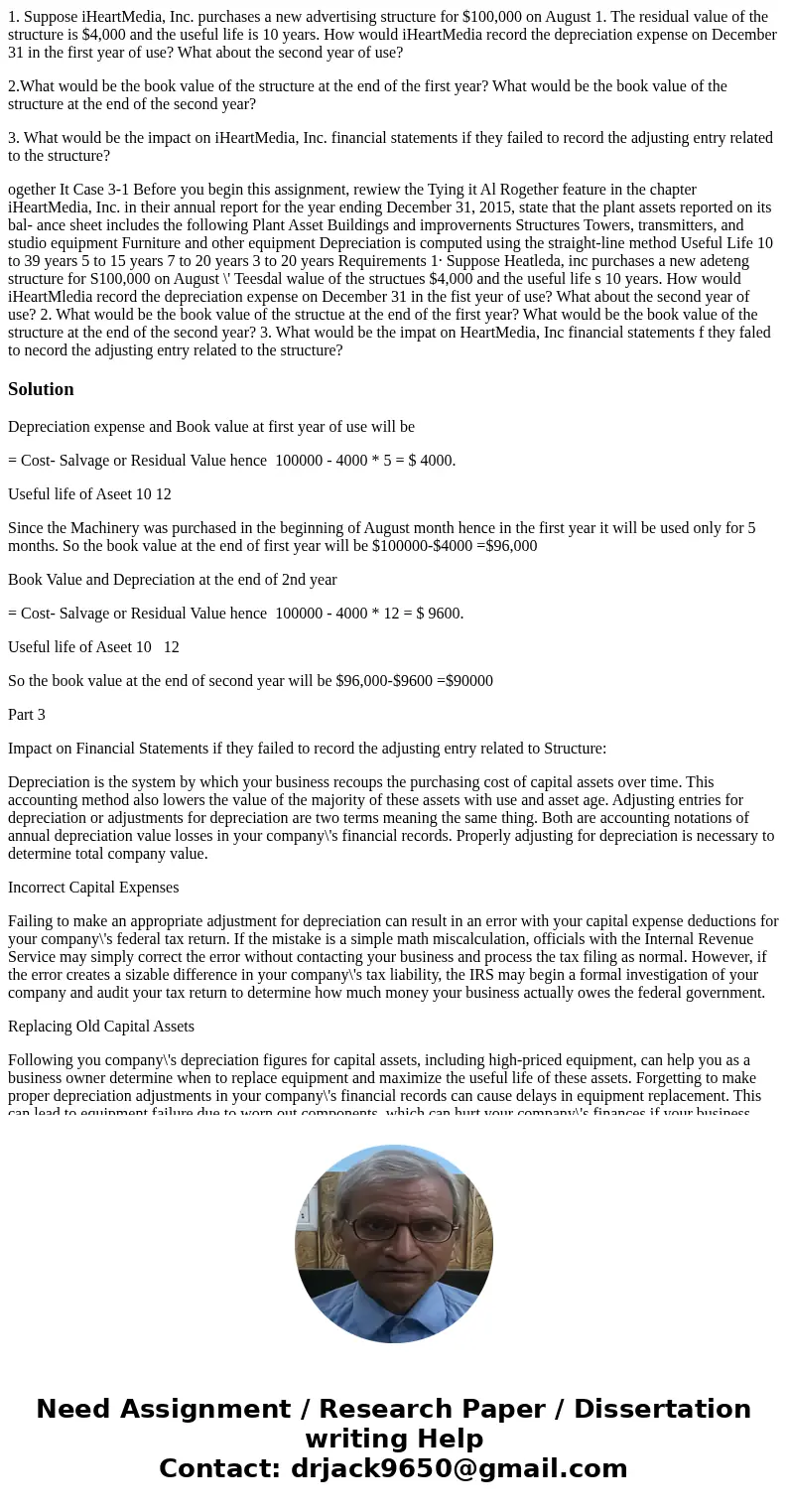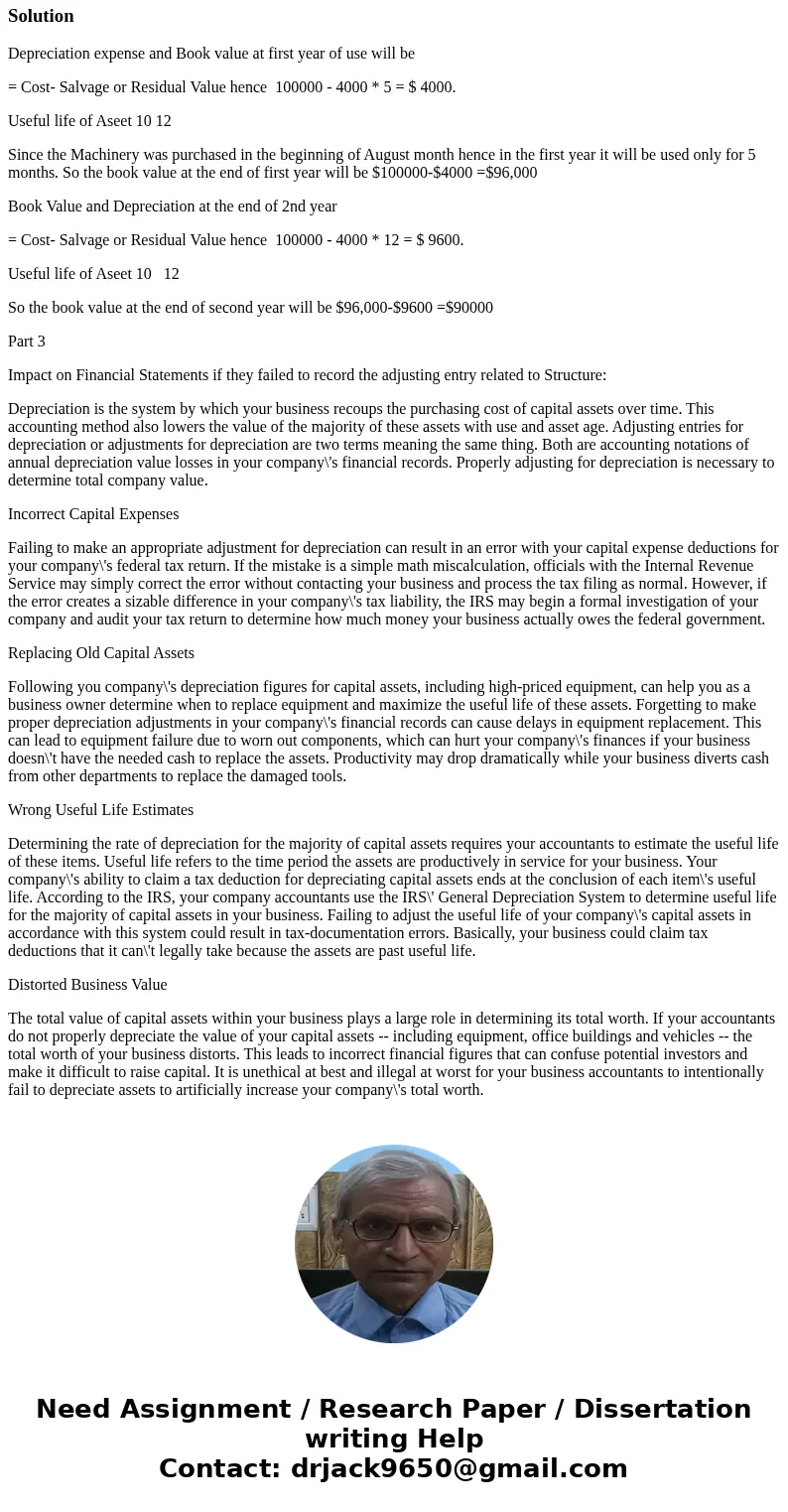1 Suppose iHeartMedia Inc purchases a new advertising struct
1. Suppose iHeartMedia, Inc. purchases a new advertising structure for $100,000 on August 1. The residual value of the structure is $4,000 and the useful life is 10 years. How would iHeartMedia record the depreciation expense on December 31 in the first year of use? What about the second year of use?
2.What would be the book value of the structure at the end of the first year? What would be the book value of the structure at the end of the second year?
3. What would be the impact on iHeartMedia, Inc. financial statements if they failed to record the adjusting entry related to the structure?
ogether It Case 3-1 Before you begin this assignment, rewiew the Tying it Al Rogether feature in the chapter iHeartMedia, Inc. in their annual report for the year ending December 31, 2015, state that the plant assets reported on its bal- ance sheet includes the following Plant Asset Buildings and improvernents Structures Towers, transmitters, and studio equipment Furniture and other equipment Depreciation is computed using the straight-line method Useful Life 10 to 39 years 5 to 15 years 7 to 20 years 3 to 20 years Requirements 1· Suppose Heatleda, inc purchases a new adeteng structure for S100,000 on August \' Teesdal walue of the structues $4,000 and the useful life s 10 years. How would iHeartMledia record the depreciation expense on December 31 in the fist yeur of use? What about the second year of use? 2. What would be the book value of the structue at the end of the first year? What would be the book value of the structure at the end of the second year? 3. What would be the impat on HeartMedia, Inc financial statements f they faled to necord the adjusting entry related to the structure?Solution
Depreciation expense and Book value at first year of use will be
= Cost- Salvage or Residual Value hence 100000 - 4000 * 5 = $ 4000.
Useful life of Aseet 10 12
Since the Machinery was purchased in the beginning of August month hence in the first year it will be used only for 5 months. So the book value at the end of first year will be $100000-$4000 =$96,000
Book Value and Depreciation at the end of 2nd year
= Cost- Salvage or Residual Value hence 100000 - 4000 * 12 = $ 9600.
Useful life of Aseet 10 12
So the book value at the end of second year will be $96,000-$9600 =$90000
Part 3
Impact on Financial Statements if they failed to record the adjusting entry related to Structure:
Depreciation is the system by which your business recoups the purchasing cost of capital assets over time. This accounting method also lowers the value of the majority of these assets with use and asset age. Adjusting entries for depreciation or adjustments for depreciation are two terms meaning the same thing. Both are accounting notations of annual depreciation value losses in your company\'s financial records. Properly adjusting for depreciation is necessary to determine total company value.
Incorrect Capital Expenses
Failing to make an appropriate adjustment for depreciation can result in an error with your capital expense deductions for your company\'s federal tax return. If the mistake is a simple math miscalculation, officials with the Internal Revenue Service may simply correct the error without contacting your business and process the tax filing as normal. However, if the error creates a sizable difference in your company\'s tax liability, the IRS may begin a formal investigation of your company and audit your tax return to determine how much money your business actually owes the federal government.
Replacing Old Capital Assets
Following you company\'s depreciation figures for capital assets, including high-priced equipment, can help you as a business owner determine when to replace equipment and maximize the useful life of these assets. Forgetting to make proper depreciation adjustments in your company\'s financial records can cause delays in equipment replacement. This can lead to equipment failure due to worn out components, which can hurt your company\'s finances if your business doesn\'t have the needed cash to replace the assets. Productivity may drop dramatically while your business diverts cash from other departments to replace the damaged tools.
Wrong Useful Life Estimates
Determining the rate of depreciation for the majority of capital assets requires your accountants to estimate the useful life of these items. Useful life refers to the time period the assets are productively in service for your business. Your company\'s ability to claim a tax deduction for depreciating capital assets ends at the conclusion of each item\'s useful life. According to the IRS, your company accountants use the IRS\' General Depreciation System to determine useful life for the majority of capital assets in your business. Failing to adjust the useful life of your company\'s capital assets in accordance with this system could result in tax-documentation errors. Basically, your business could claim tax deductions that it can\'t legally take because the assets are past useful life.
Distorted Business Value
The total value of capital assets within your business plays a large role in determining its total worth. If your accountants do not properly depreciate the value of your capital assets -- including equipment, office buildings and vehicles -- the total worth of your business distorts. This leads to incorrect financial figures that can confuse potential investors and make it difficult to raise capital. It is unethical at best and illegal at worst for your business accountants to intentionally fail to depreciate assets to artificially increase your company\'s total worth.


 Homework Sourse
Homework Sourse